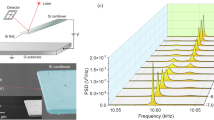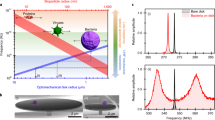Abstract
One-dimensional nanomechanical resonators based on nanowires and nanotubes have emerged as promising candidates for mass sensors1,2,3,4,5,6. When the resonator is clamped at one end and the atoms or molecules being measured land on the other end (which is free to vibrate), the resonance frequency of the device decreases by an amount that is proportional to the mass of the atoms or molecules. However, atoms and molecules can land at any position along the resonator, and many biomolecules have sizes that are comparable to the size of the resonator, so the relationship between the added mass and the frequency shift breaks down7,8,9,10. Moreover, whereas resonators fabricated by top-down methods tend to vibrate in just one dimension because they are usually shaped like diving boards, perfectly axisymmetric one-dimensional nanoresonators can support flexural vibrations with the same amplitude and frequency in two dimensions11. Here, we propose a new approach to mass sensing and stiffness spectroscopy based on the fact that the nanoresonator will enter a superposition state of two orthogonal vibrations with different frequencies when this symmetry is broken. Measuring these frequencies allows the mass, stiffness and azimuthal arrival direction of the adsorbate to be determined.
This is a preview of subscription content, access via your institution
Access options
Subscribe to this journal
Receive 12 print issues and online access
$259.00 per year
only $21.58 per issue
Buy this article
- Purchase on Springer Link
- Instant access to full article PDF
Prices may be subject to local taxes which are calculated during checkout



Similar content being viewed by others
References
Feng, X. L., He, R., Yang, P. & Roukes, M. L. Very high frequency silicon nanowire electromechanical resonators. Nano Lett. 7, 1953–1959 (2007).
Jensen, K., Kim, K. & Zettl, A. An atomic-resolution nanomechanical mass sensor. Nature Nanotech. 3, 533–537 (2008).
Li, M. et al. Bottom-up assembly of large-area nanowire resonator arrays. Nature Nanotech. 3, 88–92 (2008).
Sazonova, V. et al. A tunable carbon nanotube electromechanical oscillator. Nature 431, 284–287 (2004).
Belov, M. et al. Mechanical resonance of clamped silicon nanowires measured by optical interferometry. J. Appl. Phys. 103, 074304 (2008).
Nichol, J. M., Hemesath, E. R., Lauhon, L. J. & Budakian, R. Displacement detection of silicon nanowires by polarization-enhanced fiber-optic interferometry. Appl. Phys. Lett. 93, 193110 (2008).
Ramos, D., Tamayo, J., Mertens, J. & Calleja, M. Effect of the adsorbate stiffness on the resonance response of microcantilevers. Appl. Phys. Lett. 89, 224104 (2006).
Waggoner, P. S., Varshney, M. & Craighead, H. G. Detection of prostate specific antigen with nanomechanical resonators. Lab on a Chip 9, 3095–3099 (2009).
Dohn, S., Svendsen, W., Boisen, A. & Hansen, O. Mass and position determination of attached particles on cantilever based mass sensors. Rev. Sci. Instrum. 78, 103303 (2007).
Spletzer, M., Raman, A. & Reifenberger, R. Elastometric sensing using higher flexural eigenmodes of microcantilevers. Appl. Phys. Lett. 91, 184103 (2007).
Conley, W. G., Raman, A., Krousgrill, C. M. & Mohammadi, S. Nonlinear and nonplanar dynamics of suspended nanotube and nanowire resonators. Nano Lett. 8, 1590–1595 (2008).
Aebersold, R. & Mann, M. Mass spectrometry-based proteomics. Nature 422, 198–207 (2003).
Naik, A. K., Hanay, M. S., Hiebert, W. K., Feng, X. L. & Roukes, M. L. Towards single-molecule nanomechanical mass spectrometry. Nature Nanotech. 4, 445–450 (2009).
Burg, T. P. et al. Weighing of biomolecules, single cells and single nanoparticles in fluid. Nature 446, 1066–1069 (2007).
Ilic, B. et al. Attogram detection using nanoelectromechanical oscillators. J. Appl. Phys. 95, 3694–3703 (2004).
Yang, Y. T., Callegari, C., Feng, X. L., Ekinci, K. L. & Roukes, M. L. Zeptogram-scale nanomechanical mass sensing. Nano Lett. 6, 583–586 (2006).
Azak, N. O. et al. Nanomechanical displacement detection using fiber-optic interferometry. Appl. Phys. Lett. 91, 093112 (2007).
Babak, S. & Ashby, P. D. High sensitivity deflection detection of nanowires. Phys. Rev. Lett. 104, 147203 (2010).
Biedermann, L. B., Tung, R. C., Raman, A. & Reifenberger, R. G. Flexural vibration spectra of carbon nanotubes measured using laser Doppler vibrometry. Nanotechnology 20, 035702 (2009).
Fan, H. J., Werner, P. & Zacharias, M. Semiconductor nanowires: from self-organization to patterned growth. Small 2, 700–717 (2006).
Liew, K. M., Hung, K. C. & Lim, M. K. A continuum three-dimensional vibration analysis of thick rectangular plates. Int. J. Solids Struct. 30, 3357–3379 (1993).
Kang, J.-H. & Leissa, A. W. Three-dimensional analysis of thick, tapered rods and beams with circular cross-section. Int. J. Mech. Sci. 46, 929–944 (2004).
Gil-Santos, E. et al. Mass sensing based on deterministic and stochastic responses of elastically coupled nanocantilevers. Nano Lett. 9, 4122–4127 (2009).
Spletzer, M., Raman, A., Wu, A. Q., Xu, X. & Reifenberg, R. Ultrasensitive mass sensing using mode localization in coupled microcantilevers. Appl. Phys. Lett. 88, 254102 (2006).
Ekinci, K. L., Yang, Y. T. & Roukes, M. L. Ultimate limits to inertial mass sensing based upon nanoelectromechanical systems. J. Appl. Phys. 95, 2682–2689 (2004).
Braun, T. et al. Quantitative, time-resolved measurement of membrane protein–ligand interactions using microcantilever array sensors. Nature Nanotech. 4, 179–185 (2009).
Ndieyira, J. F. et al. Nanomechanical detection of antibiotic–mucopeptide binding in a model for superbug drug resistance. Nature Nanotech. 3, 691–696 (2008).
Cross, S. E., Jin, Y.-S., Rao, J. & Gimzewski J. K. Nanomechanical analysis of cells from cancer patients. Nature Nanotech. 2, 780–783.
Michel, J. P. et al. Nanoindentation studies of full and empty viral capsids and the effects of capsid protein mutations on elasticity and strength. Proc. Natl Acad. Sci. USA 103, 6184–6189 (2006).
Kol, N. et al. A stiffness switch in human immunodeficiency virus. Biophys. J. 92, 1777–1783 (2007).
Acknowledgements
The authors acknowledge financial support from the Spanish Science Ministry through projects TEC2009-14517-C02, CSD2007-00010 and MAT2009-08650 and from CSIC under project PIF06-037.
Author information
Authors and Affiliations
Contributions
J.T. and M.C. wrote this manuscript with input from all authors. All authors analysed and interpreted the data. A.S. and M.F.-R. built the CVD reactor and fabricated the devices. E.G. and D.R. performed the detection and mass adsorption experiments and collected the data. J.T., E.G. and D.R. developed the theoretical model. E.G., D.R. and J.T. designed the experiments. J.M. and R.G. designed the set-up for SEM carbon deposition.
Corresponding author
Ethics declarations
Competing interests
The authors declare no competing financial interests.
Supplementary information
Supplementary information
Supplementary information (PDF 517 kb)
Rights and permissions
About this article
Cite this article
Gil-Santos, E., Ramos, D., Martínez, J. et al. Nanomechanical mass sensing and stiffness spectrometry based on two-dimensional vibrations of resonant nanowires. Nature Nanotech 5, 641–645 (2010). https://doi.org/10.1038/nnano.2010.151
Received:
Accepted:
Published:
Issue Date:
DOI: https://doi.org/10.1038/nnano.2010.151
This article is cited by
-
Nanomechanical hydrodynamic force sensing using suspended microfluidic channels
Microsystems & Nanoengineering (2023)
-
Coupled mechanical oscillator enables precise detection of nanowire flexural vibrations
Communications Physics (2023)
-
High-throughput determination of dry mass of single bacterial cells by ultrathin membrane resonators
Communications Biology (2022)
-
Ultrasensitive detection of local acoustic vibrations at room temperature by plasmon-enhanced single-molecule fluorescence
Nature Communications (2022)
-
Mode coupling bi-stability and spectral broadening in buckled carbon nanotube mechanical resonators
Nature Communications (2022)



